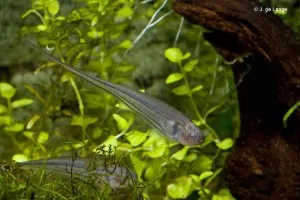Baryancistrus beggini – L239 – Blue Panaque
Baryancistrus beggini was officially described in 2009 by Lujan, Arce, and Armbruster.
In the aquarium trade, they were called Blue Panaque before they were officially described. As you can deduce from the genus name, it is not a Panaque. The designation L239 should actually no longer be used. The L-number expires when a species is officially described. However, many shops and enthusiasts continue to use the easy, short L-number designation.
Description
Baryancistrus beggini is suitable for a community aquarium but can be very aggressive to other armored catfish, other Blue Fins in particular. This species is in fact reasonably territorial: finding and preserving caves suitable for building a nest is usually the stumbling block. More than one Blue Fin ‘Panaque’ in a cramped tank can result in injury or even death to one or more fish. They can be kept together in a spacious aquarium with a lot of decoration.
The minimum aquarium size for a single fish is 80x30x30 centimeters. For a group of 3-4 fish, at least a heavily decorated aquarium of 120x40x40 centimeters is required.
Maximum length
They grow up to about 12 to 15 centimeters long.
Water parameters
Temperature: 25 – 30°C
pH: 5.5 – 7.5
Origin
South America: Headwaters of the Rio Orinoco, Amazonas, Venezuela, and Colombia.
Diet
Due to the large sucking mouth, set with many very small teeth, this species is a so-called “Aufwuchs” eater. Aufwuchs is the organic layer, partly vegetal, partly composed of small organisms (crustaceans, freshwater sponges, small insects, insect eggs and larvae, and plankton), which form on submerged surfaces, and which these armored catfish graze.
Once acclimatized, the Blue Fin ‘Panaque’ is otherwise not very picky, and in most cases will eat both meaty food (shrimp, krill, mussels, mosquito larvae, bloodworms) and vegetable food (blanched vegetables, tablets, algae, and, to our chagrin, of many aquarists, including aquarium plants).
The Aquarium
This strikingly colored catfish prefers a dimmed aquarium with plenty of hiding places in the form of plants, driftwood, rocks and/or artificial caves. To keep several specimens of this species, or to keep this species together with other bottom dwellers, an aquarium of 120x50cm is required, as the species can be quite territorial. With a lack of suitable hiding places or too little space, the Blue Fin ‘Panaque’ can behave quite aggressively towards other bottom dwellers. If it is the only bottom dweller in the aquarium, an aquarium of 100x40cm. ample. Juveniles can be kept temporarily in smaller aquariums without any problems, as long as there are sufficient hiding places.
This species does best in soft, slightly acidic to neutral water, richly supplied with oxygen and with a lot of currents. A strong filter is important, as this fish produces a lot of waste due to its barely satisfying hunger.
Comments
The Blue Fin ‘Panaque’ is known as a catfish that is difficult to acclimate. Many of these fish die prematurely during the first month in captivity due to stress and malnutrition. Another problem with recently imported specimens is the degradation of the bacterial intestinal flora. This has been disrupted by transport. The result is digestive problems and a greatly reduced absorption of extremely important nutrients. This is especially important during the first weeks.
Fish offered for sale must have been demonstrably quarantined at the importer/trader for at least a number of weeks. This is to guarantee reasonable chances of survival. Fish with sunken eyes and belly cannot be guaranteed to survive. As a rule, they die within a few weeks. So save yourself a lot of frustration. Check the fish carefully before purchasing to avoid disappointment.
Once home, it is highly recommended to keep the fish in a quarantine aquarium for a few more weeks. This allows the fish to get used to life in captivity and the local water values. It should also be checked during this period whether the Baryancistrus beggini is eating well. Depending on the food offered, there should then be red to dark brown colored thin, solid strands of feces in the aquarium. These are also called spaghettis by hobbyists. It is a sign that the animal is eating the food. In addition, it can be determined which types of food are accepted and which are not. Once the fish eats well, is active, alert, and looks healthy (good coloring, bulging belly, slightly bulging, clear eyes), it can be transferred to a larger tank.
Additional information
Despite its misleading trade name, the Blue Fin ‘Panaque’ is not part of the genus Panaque. This species has little to nothing in common with these large, wood-eating Armored Catfish in appearance, behavior, and diet. The question to which genus this species belongs was clarified in 2009 when ichthyologists Lujan, Arce & Armbruster scientifically described this species as Baryancistrus beggini. But the last word does not seem to have been spoken on this, as not everyone seems convinced that the Blue Fin ‘Panaque’ actually belongs to the Baryancistrus genus.
Video
Authors
Jonas Hansel – Piranha-info.com
John de Lange
Copyright images
Jonas Hansel – Piranha-info.com








Reviews
There are no reviews yet.